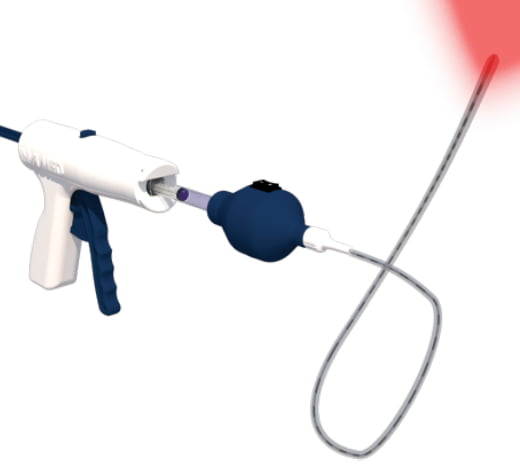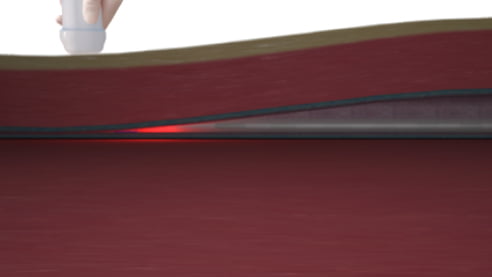What is VenaBlock?
VenaBlock is used in treatment of varicose veins where a medical adhesive is injected into the problem vein in the leg under ultrasound guidance. The vein is sealed shut by this ‘glue’, causing it to harden, heal and be absorbed into the body. Unlike heat-based procedures such as Endovenous Laser or Radiofrequency Ablation, with medical adhesive closure with VenaBlock, there is no risk of skin burns or nerve damage.

What does VenaBlock treat?
- Perforator veins
- The saphenous vein
Perforator veins connect two systems of veins; the deep vein system and the surface veins in the limbs. When perforator veins are healthy and working well they return deoxygenated blood to the heart by connecting the surface veins to deeper veins. When the one-way valves within perforator veins are defective, blood can leak backwards, creating varicose veins in surface veins.
With VenaBlock, very small amounts of glue (usually 0.1 to 0.2 ml) is injected with ultrasound guidance directly into the perforator, instantly sealing it and permanently blocking the abnormal leakage of blood from the deep system into the superficial varicose veins. It is relatively quick to perform, and is used in conjunction with sclerotherapy and thermal ablation to provide the best possible results for patients.
What happens during a Medical Adhesive Closure Procedure using VenaBlock?
Treating Perforator Veins
- A duplex ultrasound is used to map out the incompetent perforator.
- Local anaesthetic is applied to the area to be treated.
- A small amount of medical adhesive (VenaBlock) is drawn into a 1ml Syringe (usually about 0.1 to 0.2 mls of VenaBlock Glue).
- The glue is injected into the perforator vein while applying pressure from the outside with the ultrasound probe. This fully seals the perforator preventing the flow of blood into the superficial varicose veins.
- Once full vein closure is confirmed with ultrasound, Dr Paraskevas may proceed with ultrasound guided sclerotherapy of the associated varicose veins.
- Patients are encouraged to walk around immediately after the procedure and normal routines can be returned to almost immediately.
- After the procedure, the vein will harden (a process referred to as sclerosis) and will be gradually absorbed by the body.
Treating the Saphenous Vein
- A duplex ultrasound is used to map out and assess any diseased veins.
- Local anaesthetic is applied to the area to be treated.
- A catheter is inserted into the problem vein using ultrasound guidance.
- Medical adhesive (VenaBlock) is injected into the vein while applying pressure from the outside with the ultrasound probe. This fully seals the vein and reroutes blood flow through other healthy veins.
- Once full vein closure is confirmed with ultrasound, the catheter is removed and a single adhesive bandage is applied.
- Neither compression stocking or compression bandages are required after this procedure.
- Patients are encouraged to walk around immediately after the procedure and normal routines can be returned to almost immediately.
- After the procedure, the vein will harden (a process referred to as sclerosis) and will be gradually absorbed by the body.

VenaBlock is injected under ultrasound guidance
Frequently Asked Questions VenaBlock
How does medical adhesive closure using VenaBlock work?
Is loss of the vein a problem?
What are the advantages of VenaBlock?
- A walk-in, walk-out procedure. No hospital stay.
- Minimal discomfort: there is no need for injection of tumescent anaesthetic along the course of the vein.
- You can return to normal activities quickly.
- Short procedure time.
- No need to wear compression stockings after the procedure.
- No skin pigmentation, lesions, burn marks, numbness post-procedure.
What are the disadvantages of VenaBlock?
- Treated veins may become inflamed and require anti-inflammatories and time to settle. This is however, no different to other varicose vein treatments, such as endovenous laser treatment.
- VenaBlock is not covered by Medicare currently and is an expensive procedure.
Further Patient Information VenaBlock
What should you do before VenaBlock?
- Do not cease medications prior to treatment unless otherwise advised.
- Do not shave your legs immediately prior to your treatment.
- Do not apply moisturizer on the day of treatment.
- Wear slacks or loose trousers to the appointment and ensure you have a pair of comfortable walking shoes.
- Pre-medication is generally not necessary. If you have a low pain threshold, take 2 paracetamol tablets or 2 Ibuprofen tablets (with food).
What happens after the VenaBlock procedure?
- Our nurse will discuss all the important post treatment instructions in detail and provide you with a post instruction sheet.
- You will be directed to go for an immediate 10-minute walk before you drive home. If you are able to walk unaided without restriction, you will be allowed to drive home.
- You will be given Dr Paraskevas’ after hours number should you have any problems or concerns.
- Walking for 10-15 minutes per day is advised.
- Maintain normal daytime activities but avoid standing still for long periods of time.
- Continue with normal exercise activities within 48 hours.
- You will be asked to avoid long haul flights (>4 hours of continuous travel) for at least 3-4 weeks after the treatment. If travel is unavoidable, then you will be protected from Deep Vein Thrombosis with Subcutaneous Low Molecular Weight Heparin (aka Clexane) during your travel.
- An ultrasound check of the treated veins will occur 2 weeks after the treatment. This is to assess the outcome of the treatment and to exclude the very low chance of deep vein occlusion.
What are some of the side effects following VenaBlock?
- Mild to moderate pain persists for 1-2 weeks along the glued vein. Post VenaBlock discomfort should be managed with a combination of light walking and rest (with leg elevation), anti-inflammatory medication such as Nurofen or Voltaren.
- Phlebitis or inflammation may occur along the inner thigh in line with the treated vein. This is again managed with anti-inflammatories and stockings. Dr Paraskevas must be contacted if this occurs.
- Paraesthesia (skin numbness) – has been reported in some studies and is thought to be a result of inflammation around the treated vein temporarily affecting surrounding nerves.
What are the possible complications from VenaBlock?
- Complications can occur even with perfect technique.
- Deep vein thrombosis. Internal vein clots are extremely rare following VenaBlock treatments. Pulmonary embolus is also very rare.
What standards and guidelines are in place for practitioners in phlebology?
Medicare Rebate & Costs
The cost of treating varicose veins depends on severity of the veins as well as which treatment is used. We discuss these costs in detail at your initial consultation.
A Medicare rebate is claimable on all varicose vein procedures, except the most superficial spider veins.

What to expect
Learn all about your first appointment, what's included, and how much it will cost.
